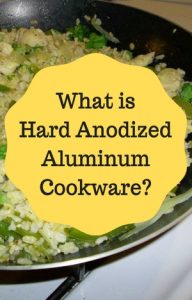 Many non-stick pots and pans are made with an aluminum base, but hard anodized aluminum is becoming more and more popular. Anodizing is an electrochemical hardening process that’s used to increase the thickness of the oxide layer on the metal surface. This material is even stronger than stainless steel and more chip resistant. This process is ideal to significantly harden it and make it stronger and last longer. Cookware made from a hard anodized base typically has a longer lifespan than a regular aluminum base. Some brands pour a non-stick coating on top of the base of either Teflon or ceramic, while other brands manufacture the pans solely with the anodized surface, turning the interior finish into one that is durable, decorative and is also resistant to corrosion. While regular aluminum construction performs well because of its great heat conductivity, the anodized does an even better job with quick and even heating.
Many non-stick pots and pans are made with an aluminum base, but hard anodized aluminum is becoming more and more popular. Anodizing is an electrochemical hardening process that’s used to increase the thickness of the oxide layer on the metal surface. This material is even stronger than stainless steel and more chip resistant. This process is ideal to significantly harden it and make it stronger and last longer. Cookware made from a hard anodized base typically has a longer lifespan than a regular aluminum base. Some brands pour a non-stick coating on top of the base of either Teflon or ceramic, while other brands manufacture the pans solely with the anodized surface, turning the interior finish into one that is durable, decorative and is also resistant to corrosion. While regular aluminum construction performs well because of its great heat conductivity, the anodized does an even better job with quick and even heating.
Electrochemical process
This electrochemical process is really quite a simple one. The base of the pan is first submerged in a chemical (sulfuric acid) bath, and then applying a low electrical charge to it. During this process, an oxide acid is produced from the layer that forms on the surface. Once the oxide layer is cooled the outer shell of the pan anodizes and becomes extremely hard almost immediately — much harder and stronger than even stainless steel.
Benefits of a hard-anodized aluminum base
- Can be used on the stove top and in the oven
- Has a harder body than stainless steel
- Cookware has a longer lifespan and is more durable
- Better heat conductivity than a regular base

Aluminum provides an extremely even heating base but some folks are concerned about the metal leaching into food if the Teflon or ceramic surface becomes worn. The hard-anodized surface will prevent this from happening.
One drawback
Although the finish is extremely hard and durable, it’s also delicate in the sense that it will require some extra care. The cookware should be hand-washed only (unless you’re not concerned about what the finish will look like). The coating will wear out and breakdown in the dishwasher. The breakdown process will cause discoloring and staining and can leave a chalky residue or film on the he pans. This film will rub off on your hands, kitchen towels, your clothes, or anything else it may come in contact with.
The reason for this is because of the phosphorus and caustic soda in most dishwasher detergents. They are extremely harsh and will react negatively with the finish.
Another thing to note is that even though the skillets and pots have a more durable body, they should be carefully stored to prevent any scratches or dents to the surface.
You can do this by placing paper towels in between the pans if you’re stacking them in a cabinet, or you can use a pot rack to hang them, giving them a decorative accent to your kitchen.
If you’re looking for a ceramic coated cookware set with a hard-anodized body, the GreenLife Gourmet set may be a great choice for you. You can read my review here.The cooking properties are excellent as both the base and the ceramic coating combined make for quick and even heating. The body is extra durable, and the ceramic coating is non-stick, making it a breeze to clean. You can check out more about the set by reading my review.
